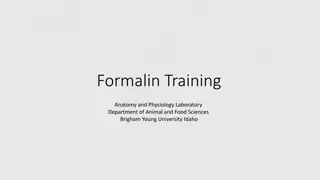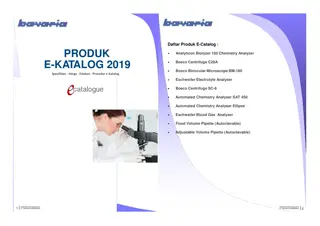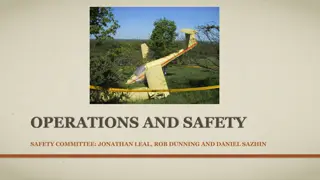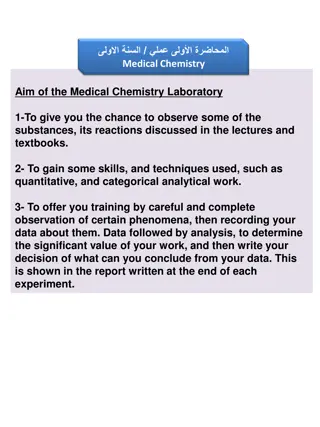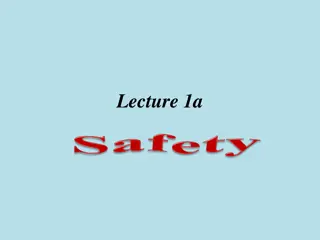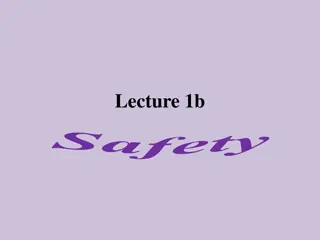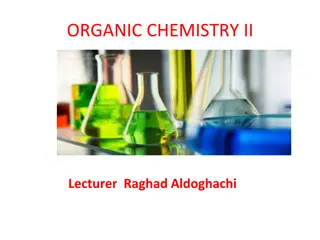Laboratory Safety Guidelines and Procedures for Chemistry Students
Laboratory safety is crucial in chemistry courses to prevent accidents and ensure a safe working environment. This guide includes marking criteria, laboratory regulations, emergency procedures, safety rules, and lab tools. It emphasizes the importance of following safety protocols, handling equipment properly, and being prepared for emergencies in the lab.
Download Presentation

Please find below an Image/Link to download the presentation.
The content on the website is provided AS IS for your information and personal use only. It may not be sold, licensed, or shared on other websites without obtaining consent from the author. Download presentation by click this link. If you encounter any issues during the download, it is possible that the publisher has removed the file from their server.
E N D
Presentation Transcript
Marking criteria 1- Quiz ( 4 marks). 2- Final lab exam ( 15 marks). 3- safety and behaviour ( 1 mark ). 4- lab report ( 5 marks)..
Outline 1- laboratory regulations 2- Emergency procedure. 3- Safety rules and first aid procedures. 4- Lab tools and signs
laboratory regulations 1- Read each experiment thoroughly before entering the lab. 2- Discard solids into the waste crocks. 3- leave reagent bottles at the side shelves. 4- Read the labels . 5- Avoid using excessive amounts of reagents.
6- Never return unused chemicals to the stock bottle. 7- Don t inset your own pipets or medicine droppers into the reagent bottles. 8- Don t lay down the stopper of a bottle. 9- Don t heat heavy glassware . 10- Always maintain a clean work area in the laboratory.
11- Wash glassware with water and a cleaner if needed. 12- When heating a liquid in a test tube point it away in case it pumps.
Emergency procedure 1- Notify the instructor or demonstrator immediately in case of accident. 2- learn the location and proper use of fire extinguisher, blanket, first-aid kit. 3- Spillage of corrosive chemicals must be reported.
Safety rules and first aid procedures 1- Wear safety glasses in the lab and gloves. 2- Don t eat or drink in the lab. 3- Never attempt unauthorized experiments.. 4- Never leave heated laboratory reactions unattended.
6- No practical jocks. 7- Never dip pipets or spatulas into reagent bottles and don t return unused portion to the stock bottles. 8- Be familiar with emergency exit. 9- Be prepared to administer first aid .
Lab tools 1- Florence flask:- It is also known as a boiling flask. It is designed to be used for uniform heating and ease of swirling; it is produced in a number of different glass thicknesses to stand different types of use.
2- Beaker : It is a simple container for stirring, mixing and heating liquids . They are generally cylindrical in shape, with a flat bottom.
3- Funnel: Different kinds of funnels that have been adapted for these specialized applications in transferring liquids to other containers through filtration. laboratory. Main usage is
4- filter flask: A filter flask is a flask fitted with a side arm for connecting to a vacuum source for fast filtering.
5- Mortar and pestle: It is a tool used to grind and mix substances.
Graduated cylinder 5- Graduated cylinder : used to measure the volume of a liquid. Graduated cylinders are generally more accurate and precise than laboratory flasks and beakers.
Powder funnel 6- Powder funnel : It has a small and wide neck for fast pouring of powders.
Erlenmeyer flask 7- Erlenmeyer flask: The Erlenmeyer is usually marked on the side (graduated) to indicate the approximate volume of contents, and has a spot of ground glass or enamel where it can be labeled with a pencil. It differs from the beaker in its tapered body and narrow neck.
Mohr pipette 8- Mohr pipette : Also known as a Graduated pipette, it is used to measure the volume of the liquid dispensed, although not as accurately as a volumetric pipette.
Test tubes 9- Test tubes: Test tubes are widely used by chemist to hold, mix, or heat small quantities of solid or liquid chemicals, especially for qualitative experiments and assays.
Crucible and cover 10- Crucible and cover: A crucible is a ceramic container capable of withstanding extreme temperatures, whilst the cover is designed to prevent heat escaping from the crucible itself.
Test tube holder 11- Test tube holder: The test tube holder is used to hold test tubes. They are used by squeezing the handles to open the other end, and inserting the test tube. Test tube holders are typically used when heating the test tube is necessary, or for when caustic materials are being handled.
Evaporating dish 12- Evaporating dishes : Are used to evaporate excess solvents, most commonly water - to produce a concentrated solution or a solid precipitate of the dissolved substance.
Test tube brush 13- Test tube brush: Designed to clean test tubes.
Thermometer 14- Thermometer: It is a device that is used to measure temperature in different principles.
Test tube rack 15- Test tube rack: it is used to hold/support test tubes containing chemicals waiting for further operations.
Buchner funnel 16-Buchner funnel: It is used in filtrations .
Distilling flask 17- A distilling flask: Is used to separate mixtures of two liquids with different boiling points. Distillation occurs when the flask is heated and the components of the mixture change from liquid to gas, with the lowest boiling point liquids changing first and liquids with the highest boiling points changing last.
Ring stand, with rings 18- The ring stand : Used to support laboratory apparatus.
Burette clamp 19- A burette clamp is used to fasten glassware into place on a ring stand. Other clamps are condenser and pinchcock clamps.
continue 20- Bunsen burner: is used for heating, sterilization. 21- wire gauze with asbestos center: It can be used to support a container (such as a beaker or flask) during heating as it helps to spread the heat evenly over the container.
Wing top 22- A wing top : is an accessory that can be used with a Bunsen burner to provide more uniform flame.
Wire triangle 23- wire triangle: It's composed of twisted wire running through three clay pipes in the shape of an equilateral triangle and is used to hold a crucible over the flame of a Bunsen burner.
Watch glass 24- Watch glass: used in chemistry as a surface to evaporate a liquid, to hold solids while being weighed, or as a cover for a beaker. 25- laboratory balance: Is an instrument that can be used to determine the weight and mass of an object.
26- A burette is used to deliver solution in precisely- measured, variable volumes.
Pipettes 1- Transfer pipettes 2- Graduated pipettes
Laboratory Signs and Symbols Toxic Biohazard Oxidizing Radioactive
General danger Electrical hazard Explosive Flammable
Harmful Corrosive Chemical container labeling













